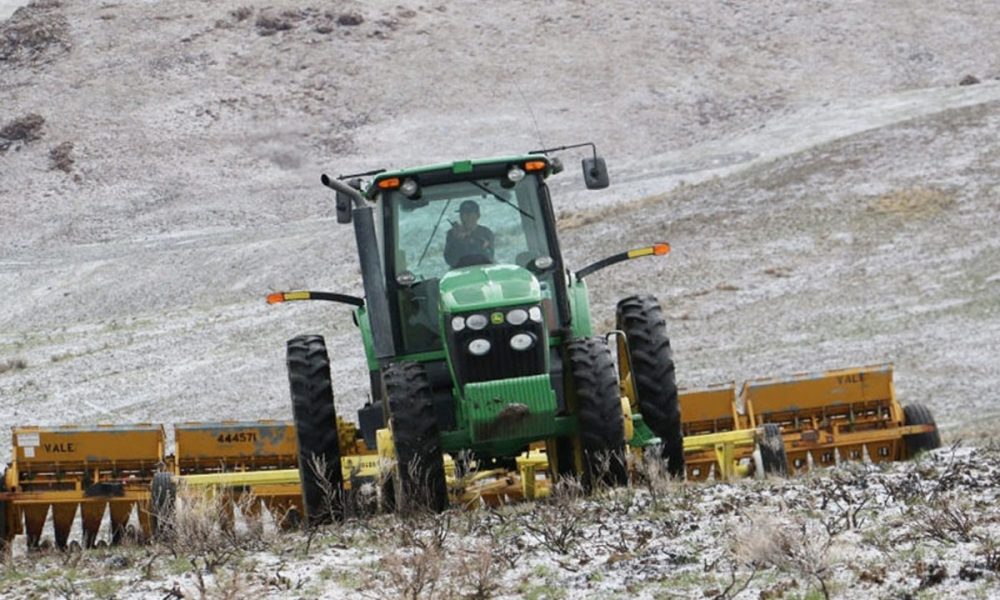
Protecting rangeland with projects such as seeding is the driving force behind a new experiment that involves grazing. (BLM photo)
JORDAN VALLEY – Rancher Mark Mackenzie is embarking a science experiment that could help cattle, sage grouse and federal rangelands.
He’s hoping to prove that cattle can help check the ever-spreading invasive weeds and grasses that are choking millions of acres of range.
The experiment will take hold on his grazing allotments this year in five-acre plots that will give clues for how to care for miles and miles of sagebrush country.
There is no time to waste, according to a new federal report. Invasive plant infestations now cover more than 100 million acres of public and private lands in the west. The plants crowd out native plants, diminish wildlife habitat, and leave little for cattle to eat.
The federal report raises the alarm that government agencies at every level must act.
“Lack of effort is due almost entirely to lack of capacity, not expertise,” said the report, “Wildfire and Invasive Plant Species in the Sagebrush Biome.” The report assesses fire and range management and was produced by the Western Association of Fish and Wildlife Agencies. The report chronicles what’s happened since the association’s 2013 report.
“The number one conservation issue facing the western sagebrush rangelands is the lack of program capacity and necessary structure for invasive plant management at all levels of government,” the association said in releasing the report. Researchers pinned blame in part on lack of “common conservation priorities” and “consistent long-term dedicated funding.”
The report said conditions that opened the door for invasive species such as cheatgrass and medusahead will likely worsen. Snowpacks are declining, droughts are more persistent and wildfire season is lasting longer.
“Invasive annual grasses and wildland fire are the most crucial threats to the sagebrush ecosystem,” the report said.

Researchers urged strong action. They said more focused work to control invasive grasses is needed and then more money should be spent on restoring rangelands damaged by such grasses or fire.
It noted a shortage of native grass seeds, encouraged citizens to act to save the ranges, and urged more research on rangeland cattle grazing.
That’s where Mackenzie comes in.
He’s ranched outside Jordan Valley for more than 40 years.
“We saw the cheatgrass just explode in this country,” said Mackenzie.
He said he has used cattle on his private land to keep the invasive grasses in check.
“It’s all about timing,” he said. “It’s not the extent of the grazing.”
Mackenzie will be part of a research project to see if fall and winter grazing can help mow down the invasive grasses. He’s sure it can. In spring and summer, he said, cattle won’t touch medusahead.
“It’s like eating a toilet brush,” he said, but that changes in fall and winter. That’s when medusahead sprouts and is green. For cows, “it’s like a fresh salad for them. They will eat it.”
The five-acre plots being mapped out on Mackenzie’s allotments will be in place for years, subjected to differing grazing approaches.
The BLM has been experimenting in neighboring Harney County.
Louisa Evers, BLM science coordinator in the Oregon-Washington unit, said winter grazing there has proven effective.
“The animals really target the annual grasses,” Evers said.
That reduces seed production and removes the fine litter that stokes range fires, but more research is needed.
“We’re not sure how well this will work in different kinds of settings,” Evers said. “It shows some promise.”
The U.S. Fish and Wildlife Service is working with federal and state agencies to test the changed grazing cycle.
“We know that grazing is not incompatible with our sagebrush rangelands,” said Dawn Davis, sagebrush ecosystem coordinator for the federal wildlife agency. “We’re still working on the best application of targeted grazing.”
Saving the public rangelands isn’t just about feeding cattle.
Davis said 350 species of wildlife and plants make up sagebrush systems.
“When you have a disturbance like fire, that removes the existing structure and converts it into a monoculture of annual invasives,” she said.
The experts note that healthy range is vital to water supplies, both for quantity and quality. Recreationalists – hikers, birders and more – lose the features that draw them to the rangelands. And hunting takes a hit.
“A healthy sagebrush landscape works not only for wildlife but for the people,” said Davis.
The federal report noted inadequate science around range grazing and in native seed production, a finding that spurs on Sergio Arispe, a livestock and range agent with the Malheur County extension office.
He is part of the team working with Mackenzie to research how grazing can push back the invasive plants.
“If we don’t take care of this, rangeland opportunities are going to dramatically shift,” Arispe said. “We’re going to be producing some ground-breaking science for this area.”
A paper describing the project explained the goal is to “improve the economic viability of rangeland-based beef operations and provide healthy habitat for wildlife – like sage grouse – in a socially responsible manner.”
Don Gonzalez, BLM Vale District director, said his team is still digesting the latest federal report. He said a lot of work is being done in the district to control invasive species but “we’re seeing some spread rates that are pretty good.”
In the last three years, the BLM has spent $20 million on treating rangelands in Oregon, and expects to have hit a total of 1.5 million acres by the end of this year.
The federal report noted, however, that funding for restoring damaged rangelands is unstable.
“We don’t necessarily have the most appropriate tools to restore the habitat,” said Davis, the federal sagebrush coordinator.
Mackenzie, though, is certain cattle are a key to that restoration. He is confident the scientific work that starts this summer will prove it.
“I know what the outcome’s going to be,” he said. “It’s going to be great.”
But he also knows that just as the invasion of annual grasses occurred over years, restoring sagebrush country will take years.
“This is not a quick fix,” he said.
Les Zaitz: [email protected], 541-473-3377.




